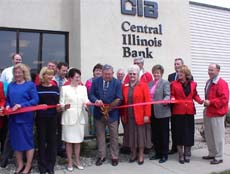|
Scully
Park rededication
set for Saturday
[MAY
25, 2000] Main
Street Lincoln volunteers have been hard at work getting Scully Park
in downtown Lincoln ready for its rededication Saturday, May 27, at
10 a.m. The park will become more welcoming and user-friendly with
new lights, a restored fountain, picnic tables and attractive
plantings.
|
|
The
rededication will be attended by local officials and by seven
members of the Scully family, large landholders in the Logan
County area. Violet Scully, one of the last family members to live
in the area, donated the land for the park. She also donated the
land for Kickapoo Creek Park on the north edge of town. The ribbon
used in the ribbon-cutting to formally open the park will be
violet, in honor of Mrs. Scully. The restored fountain will be
turned on during the ceremony
Last
week a work force, mainly volunteers, was overseeing the
restoration of the fountain in the center of the park and the
addition of a section of sidewalk near the new entrance. The
volunteers were digging and rototilling, carting wheelbarrow loads
of dirt, planting flowers, and laying cables for the new light
fixtures that will go up near the fountain.

Under
way for the past year and a half, the restoration is intended to
encourage people to use the park for picnics, reunions, or just as
a place to sit and relax. Eight new picnic tables will be placed
on the grounds. New lights, designed to coordinate with the
existing fixtures Logan County installed recently, will be placed
around the fountain at a height of 10 feet for the convenience of
pedestrians.
(To top of second
column)
|

A new
ironwork entrance and an ironwork fence around the fountain have been
created by Don Bode. Flowers, including roses and butterfly gardens,
have been newly planted by Jennifer Boeke and Judy Donath. Four new
waste receptacles will encourage users to keep the park tidy.
According
to Wendy Bell, Main Street Lincoln director, funds to complete the
program have been provided by a grant from the Woods Foundation, a
local institution, the Logan County Board, and the Logan County Parks
and Trails Foundation, founded by Violet Scully. Much of the labor has
been volunteered by Main Street Lincoln members.

"Lincoln
is unique in having two parks adjacent to the downtown area, Scully
Park and Latham Park," Bell said. "Latham Park is relatively
well used, and we want more people to use this park, also."
Lincolnís second Harvest Fest, which showcases the agricultural
heritage of Logan County along with crafts and folk art, will be held
in Scully Park this year on Sept. 22 and 23, Bell said.
[Joan
Crabb]
|
|
|
Officials
explain status of storefront renovation program
[MAY
24, 2000] The men on the
scaffolding, ladders and hydraulic lifts aren't plastic surgeons, but
they're accomplishing the same thing on storefronts in downtown
Lincoln.
According
to Joan Ritter, mayor of Lincoln, and Grant Eaton, engineer for the
Environmental Management Corporation, 18 business owners are currently
enrolled in the program.
|
|
"Initially,
the grant, which is funded through the Illinois Department of
Transportation, began to put together a program that would help
business owners in towns that had an active 'Main Street' project
renovate their storefronts," Ritter said.
"At
the onset, approximately 39 owners showed interest in
participating," she added.
"Due
to the length of time it took to actually get work under way, some
owners dropped out and others decided to do the work
themselves," Ritter said.

The
first phase of the IDOT program began in 1993.
Eaton said that the first bids came in over budget and
excluded some portions of work that needed to be addressed.
"Some
of the storefronts were found to have leaded paint, Eaton said.
"In order to remove it and comply with standards established
by the Environmental Protection Agency, different procedures had
to be used," he added.

Eaton
said that the current program will cost about $900,000, with IDOT
paying 80 percent and the store owners paying 20 percent.
All
work being done has to meet standards established by IDOT and also
must maintain "Historic Preservation" codes.

"One
business was found to have an original lead glass window behind
some plywood that covered it from an earlier construction
project," Eaton said.
(To top of second
column in this article)
|

"Anything
like this that is found is restored so that the original integrity of
the building can be maintained," he said.
Contractors
that wanted to bid on any of the projects first had to be certified by
the Illinois Capital Development Board.
The contractors that were certified then worked with the
architects and IDOT to accomplish the "Enhancement Grant's"
purpose.
Although
the grant is given by IDOT to each participating town, it is then the
responsibility of the participants to administer it.
The
Main Street project, which is a self-supporting organization of
participating downtown merchants, also had a hand in making business
owners aware of the grant and what it would entail for them to
participate.
"In
June of 1999, each business was contacted and re-signed the contracts
for individual participation," Ritter said.
"Main
Street was instrumental in helping make the participants aware of the
project's status and time schedule," the mayor added.
Approximately
once a month, Eaton and the architect walk around the projects
together to determine progress, time frames, and discuss potential
problems in order to keep a handle on the renovation work.

"Work
began late this spring," Eaton said, "and is scheduled to be
concluded this fall."
An
earlier portion of the same program was a $236,000 project to replace
lighting in the downtown area. According
to Eaton, this phase was finished with the city paying 20 percent of
the tab.
If
it's true that ďYou never get a second chance to make a first
impression,Ē business owners, the city, Main Street, IDOT, CDB,
architects and contractors are all working together to achieve a
pleasant-looking downtown that maintains its historic look and invites
consumers to the many businesses located there.
[Fuzz
Werth]
|
|
|
Extending a branch
CIB moves
to Lincoln
[MAY
23, 2000] Central
Illinois Bank had a ribbon-cutting ceremony Monday morning at its new
Lincoln branch, located at 428 Keokuk St. The bank has been operating
since April 17th. The red ribbon was cut by Wally H. Reese, the senior
vice president of the Lincoln branch, with Mayor Joan Ritter and the
Lincoln/Logan County Chamber of Commerce Ambassadors in attendance.
The bank occupies the former site of Little Caesarís Pizza and is
open Monday through Friday, 8 a.m. to 5 p.m.
|
|
Central
Illinois Bankís (CIB) parent company, Central Illinois Bank
Marine Bancshares Inc., began in 1987 primarily as a commercial
bank offering business loans to finance start-up costs, working
capital, and reinvestments in facilities and equipment. It now
offers credit cards, cash management services and automated
clearinghouse capabilities. In recent years, CIB has expanded to
include all of the retail customer services. There are
approximately 40 CIB banking facilities throughout the Midwest.

[CIB's employees and the
Lincoln/Logan County Chamber of Commerce ambassadors at Monday's
ribbon-cutting ceremony]
Julie
Dreesen, president and chief operating officer of CIB, said,
"Iím very excited. Weíve got a great group of people from
the community working here. We picked the people first and then
the facility site. We are going to be a good fit in Lincoln."

The
Lincoln branch will have a staff of four and will receive direct
support as needed from its Peoria and Springfield locations. Four
full-time employees from Lincoln will run the branch office: Wally
Reese, senior vice president, business development; F. Kay Bauer,
office manager; Cindy Anderson, teller supervisor and customer
service representative; and Ginger Bryant, teller.

[Wally H. Reese, senior vice
president, business development, settles into his new CIB office.]
Reese,
an experienced banker, came out of a year and a half of retirement
to accept the helm of the new venture. According to Reese, he was
offered "a significant challenge." He had opened many
branches before but had never opened a bank. He said, "The
circumstances were right for me to spend another period of my life
in banking. I donít know how long it will be, but as long as itís
fun, Iíll probably wake up every morning and do it."
(To top of second
column in this article)
|

CIBís
philosophy is to put the customer first, which Reese said is needed in
todayís banking environment. He sees CIBís Lincoln branch as a
deposit-generating facility, with deposits used throughout Central
Illinois. Renna Hadsell, customer service operations manager from
Peoria, said, "Itís been very interesting to see a bank grow so
quickly. Iím excited about having a new office in a new area."

[CIB, the new bank in town]
Lincoln
has many fine banks already, Reese added, as a former Magna Bank
officer. "We hope to generate new business," he said.
"Although we are small in our attitudes toward how we care for
people, we are large enough to handle any lending need. We have
sufficient lending limits for any size project. We have 750 million
dollars in assets and corporate holdings of two billion dollars."

"We
are unique in that we are a small bank with the capital and strength
of a large bank," Reese concluded.
[Kym
C. Ammons-Scott]
|
|
|
[MAY
22, 2000] May
22 through June 4, which includes the Memorial Day weekend, is the
first enforcement period for the "click it or ticket"
campaign to enforce the state of Illinois mandatory seat belt law.
According to Trooper Dan Beck of Illinois State Police District 9, 305
state, county and municipal law enforcement agencies are taking part
in the campaign.
Any person stopped for any
traffic offense who is not wearing a seat belt will receive the $55
fine for non-compliance with the seat belt law, as well as the fine
for the original traffic violation. Trooper Beck said the campaign is
an effort to increase seat belt use, which is only 65.9 percent in
Illinois.
|
|



